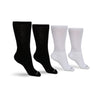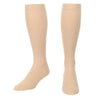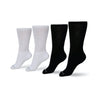Foods that Reduce Swelling in Feet and Ankles

Table Of Contents:
Swelling is the enlargement of an organ, a skin area, or other body parts like the feet and ankles. This happens when your body retains fluid in your lower legs, ankles, or feet – known as localized swelling. Weight gain can occur quickly over a short period due to the additional fluid (days to weeks). They are maybe typical and usually not a cause for worry, particularly if you have been standing or walking. However, persistently swelling feet and ankles accompanied by other symptoms may indicate a significant underlying medical issue that requires immediate medical attention.
Potential Causes for Swelling
Here, we look at some potential causes why a person's feet and ankles may appear swollen.
Infection. An infection may manifest as swelling in the ankles and feet. People experiencing diabetic neuropathy or other foot nerve issues are more likely to get foot infections. Because nerve damage can numb the pain, it's crucial to check your feet for blisters and sores every day if you have diabetes because foot problems can advance quickly. Contact your doctor immediately if you have a blister that looks infected or an enlarged foot.
Edema. This happens when excess fluid accumulates in your body's tissues. Edema can affect any area of your body, although it tends to manifest more visibly in the hands, arms, feet, ankles, and legs. Reduced mobility and discomfort are possible effects of this edema.
Lymphedema. A vast network of arteries and capillaries ordinarily carries the protein-rich fluid known as lymph along those pathways. It is filtered through lymph nodes, which entrap and eliminate undesirable elements like bacteria. But the fluid can become obstructed when there is an issue with the lymph nodes or veins. As a result, lymphatic fluid builds up in the tissues.
Foot or ankle injury
Trauma to the foot or ankle can lead to swelling in this body area. The most common example is a sprained ankle, which occurs when an accident or misstep overstretched the ligaments and causes the foot to swell.
Pregnancy
The swelling of the feet and ankles is a typical and common sign of late pregnancy. Fluid retention and increased pressure on the veins are the causes of this swelling.
Preeclampsia
While swelling during pregnancy can be a common and typical symptom. Still, suppose it develops abruptly and is severe. In that case, it could indicate preeclampsia, a serious condition in which high blood pressure and protein in the urine appear after the 20th week of pregnancy. If extreme swelling is accompanied by other symptoms, including headaches, nausea, vomiting, infrequent urine, stomach discomfort, or eye-light changes, it is crucial to call your doctor immediately.
Venous insufficiency. This happens when a person's blood cannot sufficiently travel from the legs and feet to the heart through the veins. This is due to weakened or damaged valves, causing blood to leak back down the vessels, and fluid builds up in the soft tissues of your lower legs, especially those near the feet and ankles.
Blood clot. Blood clots occur when the blood fails to flow around the body correctly, causing platelets to stick together. Leg vein blood clots have the potential to block the flow of blood from the legs back up to the heart and result in ankle and foot swelling. Two blood clots are superficial (found in the veins beneath the skin) and deep (deep vein thrombosis).
Medication side effects. Taking certain medications may result in swelling of the feet and ankles, mainly if they cause water retention.
Medications that may cause the feet and ankles to swell include the following:
- hormones, such as testosterone and estrogen
- calcium-channel blockers, a type of blood pressure medication
- steroids, including both androgenic and anabolic, and corticosteroids
- Antidepressants, including tricyclics and monoamine oxidase (MAO) inhibitors
- nonsteroidal anti-inflammatory drugs (NSAIDs)
- diabetes medications
Speak with your doctor if you suspect swelling may be caused by a medication you are taking. While some edema may be tolerable while taking the drug, more severe swelling may need changing the medication or its dosage.
Along with the variables mentioned above, lifestyle factors, including being overweight, may also contribute to swelling in the ankles and feet.
Could my diet be the underlying cause of my swollen feet?
When we think about nutrition, we often link the foods we eat with things like weight loss or eating low glycemic foods, especially when managing diabetes. Although we may not be aware of it, some foods in our diet might potentially cause issues with the foot and ankles. These foods we consume are frequently connected to inflammation resulting in swollen feet.
The anti-inflammatory properties of modern processed, refined, diluted, sweetened, salted, and other manipulated foods have been lost. These foods have undergone processing to increase their savory flavor and shelf life and include unhealthy fats and preservatives that chemically cause joint inflammation. Dairy products, high-sugar diets (including artificial sugars and sweeteners), refined grains, grain-fed meats and animals with additional hormones and antibiotics, tropical fruits, and unhealthy fats like vegetable oil and hydrogenated oils are the most frequently inflammatory foods.
So yes, swollen feet could be tied to your diet. Thus, managing what to include in your diet can help reduce swelling.
What are the foods that reduce swelling in the feet and ankles?
Omega-3 fatty acid-rich foods
As inflammation is the biggest culprit of swollen feet, foods with omega-3 fatty in conjunction with a balanced omega-6 intake have been shown to reduce inflammation in the body. Salmon and other fish, as well as fish oil supplements, are good sources of omega-3 fatty acids.
Low-Sodium Substitutes
Swollen feet usually indicate the presence of edema, and excessive salt in the diet is one of its main causes. A diet high in sodium can lead to water retention, which can cause swelling in the feet and ankles, especially after prolonged standing. Replace salty foods, including soups, sauces, potato chips, crackers, and pretzels, with low-sodium or reduced salt alternatives. Use table salt moderately and refrain from seasoning food with salt while it is being cooked. Other seasonings, such as lemon pepper or cilantro, can be used to provide taste without raising your sodium intake.
Fruits
It may sound cliché, but fruits are a nutritious alternative that might make your feet feel less swollen. Like watermelon, a fruit with naturally high water content is a fantastic option because it aids in flushing out extra water. A snack of grapes, pineapples, pears, cantaloupe, and oranges will also stop you from overindulging in processed meals and packaged snacks, which frequently contain high sodium.
Vegetables
Of course! Along with fruits, vegetables are a great choice as a natural diuretic. Eating more beets, leafy greens, onions, asparagus, and leeks can help. To add creativity to your diet, you cannot just eat veggies; you can also make juicy salads such as cucumbers, celery, and tomatoes. Avoid salty bacon bits, sauces, and salted croutons when making salads and vegetable dishes to keep them nutritious and low in sodium. When flavoring cooked vegetable meals or combining prepared fresh vegetable dips, check the salt content of the seasoning mixes.
Vitamin B sources
Swelling in the extremities is frequently caused by a B vitamin deficit, specifically a B-1 and B-2 insufficiency. For example, a deficiency in vitamin B-1 can result in fluid accumulation around the heart, impairing the heart's capacity to pump blood effectively and resulting in leg swelling. Consume foods rich in the B-complex vitamins, such as spinach, kale, and sea vegetables. Select fresh or frozen options rather than canned ones, which frequently have extra sodium added. Additionally, whole grains in bread and morning cereals are a great source of B vitamins.
2 comments
Best Sellers
-
Men's Cotton Diabetic Crew Socks (6 Pair)
![]()
- Regular price
- $39.99
- Sale price
- $39.99
- Regular price
-
$79.95 - Unit price
- per
Sold out





-
Men's Cotton Diabetic Ankle Socks (6 Pair)
![]()
- Regular price
- $39.99
- Sale price
- $39.99
- Regular price
-
$69.95 - Unit price
- per
Sold out


-
Men's Ultra-Soft Upper Calf Diabetic Socks (4 Pair)
![]()
- Regular price
- from $39.99
- Sale price
- from $39.99
- Regular price
-
$79.95 - Unit price
- per
Sold out


-
Women's Cotton Diabetic Crew Socks (6 Pair)
![]()
- Regular price
- $39.99
- Sale price
- $39.99
- Regular price
-
$79.95 - Unit price
- per
Sold out




-
Women's Cotton Diabetic Ankle Socks (6 Pair)
![]()
- Regular price
- $39.99
- Sale price
- $39.99
- Regular price
-
$79.95 - Unit price
- per
Sold out


-
Men's Over The Calf Compression Stocking Socks (1 Pair)
![]()
- Regular price
- from $19.99
- Sale price
- from $19.99
- Regular price
-
$31.95 - Unit price
- per
Sold out





-
Women's Ultra-Soft Upper Calf Diabetic Socks (4 Pair)
![]()
- Regular price
- from $39.99
- Sale price
- from $39.99
- Regular price
-
$79.95 - Unit price
- per
Sold out


-
DSC Hemp Cream For Neuropathy Aches & Nerve Pain (Peppermint)
![]()
- Regular price
- from $39.99
- Sale price
- from $39.99
- Regular price
-
$59.95 - Unit price
- per
Sold out










I loved this article because now I will check my diet to see what I need to correct to bring down these swelling feet & ankles.
I love this article. I didn’t have to pick from 4or 5 ads to get what I was looking for. It told me what I wanted to hear. Thanks for the information.